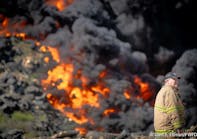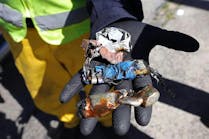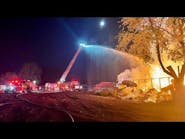Fighting fire is dangerous enough but the members of Ossining, New York’s Holla Hose Company No. 5 have a bit more to contend with – they’re first due at Sing Sing, one of America’s most infamous prisons.
Built on the eastern bank of the Hudson River in 1826, the Sing Sing Correctional Facility and town drew its name from the Sint Sinck Indians who inhabited the area. “The Big House” and “up the river” are terms born at the imposing maximum-security institution.
Sing Sing’s Death House executed 614 inmates between 1891 and 1963. Gangsters like Louis “Lepke” Buchalter of Murder Inc. and high-profile Cold War criminals Julius and Ethel Rosenberg walked their last mile to Sing Sing’s electric chair. Legendary bank robber Willie Sutton went over the east wall of the 55-acre facility just behind Holla Hose’s old station in 1932.
Government leader J. Edward Holla founded the fire company in 1900 when residents of southern Ossining worried that existing Ossining companies weren’t close enough to their area. Hence, “The Pride of the South Side” was born. Today, Holla Hose’s modern two-bay station on State Street overlooks “A”-block, which ranks as one of the largest prison buildings in the U.S. at nearly 600 feet long. The daily shouts of Sing Sing’s 2,000 inmates (nearly 700 are murderers) drift up the hill past the brick firehouse.
What’s it like protecting such a notorious facility as Sing Sing? Ossining Ex-Chief Mike Moran downplayed Holla’s unique assignment. “It’s like any basic job,” he said. “You have concerns, but you do your job.” But he added, “You think about the people. It’s a dangerous element.”
Even the town attempted to distance itself from the dark specter of Sing Sing when it changed its name to Ossining at the turn of the century. In 1970, the State of New York followed suit by changing the institution’s name to the Ossining Correctional Facility. By 1983, however, new signage touted a return to “Sing Sing.”
The Ossining Fire Department consists of nine volunteer companies that operate from seven stations. They cover Ossining’s 5.8 square miles and 28,000 residents. Joining Holla first due at Sing Sing is Cataract Hose No. 2 (Engine 97), Senate Hook & Ladder No. 1 (Ladder 41) and the department’s rescue company.
Times have changed since Holla’s first motorized piece, a 1922 four-cylinder Stutz, whined from its quarters at State and Lafayette streets abutting Sing Sing’s towering walls. Today, Engine 100, a 2001 American LaFrance 1,500-gpm pumper, makes 150 runs a year. “It’s basically an old-timers company,” said Fred Coutant, a 36-year member who works as a butcher at Sing Sing.
Still, Holla Hose’s station has the distinction of offering the prettiest view of the majestic Hudson River just beyond the prison’s guard towers. The sprawling hills of Rockland County and the Tappan Zee Bridge to the south provide a postcard setting. “I guess we take for granted living here,” Moran said. “We don’t think about the beautiful view.”
Many afternoons, Coutant hosts members who stop by for small talk just like at any American firehouse – except that their view is of the east towers and a massive complex of barred windows. The walls of Holla’s spacious lounge are covered with plaques and photos of fires where Holla Hose was first due. The 1999 multi-alarmer at an eight-story apartment building on Charter Circle and the Liberty Street paint factory fire in 1969 generate many war stories.
Frequently, tourists cruise by Sing Sing’s daunting 24-foot-high walls. Even Hollywood finds Sing Sing exciting. Many films have been shot there, dating back to 1938’s “Angels With Dirty Faces” and, more recently, Robert DeNiro’s gangster character ended up there in “Analyze This.”
Fires at Sing Sing have been few and far between over the years. In 1984, the roof of the original prison building burned. That followed a major hostage incident in 1983. “We also had an all-hands fire in the laundry facility in a snow storm,” Moran recalled.
Today, most incidents within the prison are handled by a fire brigade of correctional officers, one of whom serves as on-site fire chief. When Ossining’s Bravest respond inside, fire apparatus stops over a large pit where a corrections officer inspects the undercarriage. A head count is taken, too. “And you’d better have the same number on the way out as you did on the way in,” Moran said. He added, “It’s in the back of your mind all the time, but you have a job to do.”
Joseph Louderback, a Firehouse® contributing editor, served as editor of the FDNY’s Publications Unit and as a government affairs reporter. He is a 20-year member of the Milmont Fire Company in Milmont Park, PA, and conducts media relations programs for the fire service.





